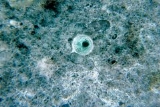
Archamoebae
Encyclopedia
The Archamoebae are a group of Amoebozoa
distinguished by the absence of mitochondria
. They include genera that are internal parasite
s or commensal
s of animals (Entamoeba
and Endolimax
). A few species are human pathogens, causing diseases such as amoebic dysentery
. The other genera of archamoebae live in freshwater habitats, and are unusual among amoebae in possessing flagella
. Most have a single nucleus
and flagellum, but the giant amoeba Pelomyxa
has many of each.
Early molecular trees based on rRNA placed the parasitic or commensal genera (entamoebids) and the flagellate genera (pelobionts) as separate groups that diverged from other eukaryote
s very early on, suggesting that the absence of mitochondria was a primitive condition. The absence of dictyosome
s in Pelomyxa was also considered primitive, which would separate it from Entamoeba, which has dictyosomes.
The name Archamoebae, from Greek αρχη first, refers to this presumed antiquity. However, studies based on other genes have shown that this placement is an artifact of long-branch attraction. Instead, the Archamoebae are part of the Amoebozoa that have lost their mitochondria, and are particularly close relatives of the slime mould
s. It also appears the pelobionts and entamoebids are not separate groups, i.e. Entamoeba and Endolimax developed separately from free-living ancestors.
Amoebozoa
The Amoebozoa are a major group of amoeboid protozoa, including the majority that move by means ofinternal cytoplasmic flow. Their pseudopodia are characteristically blunt and finger-like,...
distinguished by the absence of mitochondria
Mitochondrion
In cell biology, a mitochondrion is a membrane-enclosed organelle found in most eukaryotic cells. These organelles range from 0.5 to 1.0 micrometers in diameter...
. They include genera that are internal parasite
Parasitism
Parasitism is a type of symbiotic relationship between organisms of different species where one organism, the parasite, benefits at the expense of the other, the host. Traditionally parasite referred to organisms with lifestages that needed more than one host . These are now called macroparasites...
s or commensal
Commensalism
In ecology, commensalism is a class of relationship between two organisms where one organism benefits but the other is neutral...
s of animals (Entamoeba
Entamoeba
Entamoeba is a genus of Amoebozoa found as internal parasites or commensals of animals.In 1875, Fedor Lösch described the first proven case of amoebic dysentery in St Petersburg, Russia. He referred to the amoeba he observed microscopically as 'Amoeba coli'; however it is not clear whether he was...
and Endolimax
Endolimax
Endolimax is a genus of amoebozoa that are found in the intestines of various animals, including the species E. nana found in humans. Originally thought to be non-pathogenic, studies suggest it can cause intermittent or chronic diarrhea...
). A few species are human pathogens, causing diseases such as amoebic dysentery
Dysentery
Dysentery is an inflammatory disorder of the intestine, especially of the colon, that results in severe diarrhea containing mucus and/or blood in the faeces with fever and abdominal pain. If left untreated, dysentery can be fatal.There are differences between dysentery and normal bloody diarrhoea...
. The other genera of archamoebae live in freshwater habitats, and are unusual among amoebae in possessing flagella
Flagellum
A flagellum is a tail-like projection that protrudes from the cell body of certain prokaryotic and eukaryotic cells, and plays the dual role of locomotion and sense organ, being sensitive to chemicals and temperatures outside the cell. There are some notable differences between prokaryotic and...
. Most have a single nucleus
Cell nucleus
In cell biology, the nucleus is a membrane-enclosed organelle found in eukaryotic cells. It contains most of the cell's genetic material, organized as multiple long linear DNA molecules in complex with a large variety of proteins, such as histones, to form chromosomes. The genes within these...
and flagellum, but the giant amoeba Pelomyxa
Pelomyxa
Pelomyxa are giant amoebae, usually 500-800 μm but occasionally up to 5 mm in length. One notable species is P. palustris; other described species may be synonyms, or have been moved to the unrelated genus Chaos...
has many of each.
Early molecular trees based on rRNA placed the parasitic or commensal genera (entamoebids) and the flagellate genera (pelobionts) as separate groups that diverged from other eukaryote
Eukaryote
A eukaryote is an organism whose cells contain complex structures enclosed within membranes. Eukaryotes may more formally be referred to as the taxon Eukarya or Eukaryota. The defining membrane-bound structure that sets eukaryotic cells apart from prokaryotic cells is the nucleus, or nuclear...
s very early on, suggesting that the absence of mitochondria was a primitive condition. The absence of dictyosome
Golgi apparatus
The Golgi apparatus is an organelle found in most eukaryotic cells. It was identified in 1898 by the Italian physician Camillo Golgi, after whom the Golgi apparatus is named....
s in Pelomyxa was also considered primitive, which would separate it from Entamoeba, which has dictyosomes.
The name Archamoebae, from Greek αρχη first, refers to this presumed antiquity. However, studies based on other genes have shown that this placement is an artifact of long-branch attraction. Instead, the Archamoebae are part of the Amoebozoa that have lost their mitochondria, and are particularly close relatives of the slime mould
Slime mould
Slime mold or mould is a broad term describing protists that use spores to reproduce. Slime molds were formerly classified as fungi, but are no longer considered part of this kingdom....
s. It also appears the pelobionts and entamoebids are not separate groups, i.e. Entamoeba and Endolimax developed separately from free-living ancestors.

